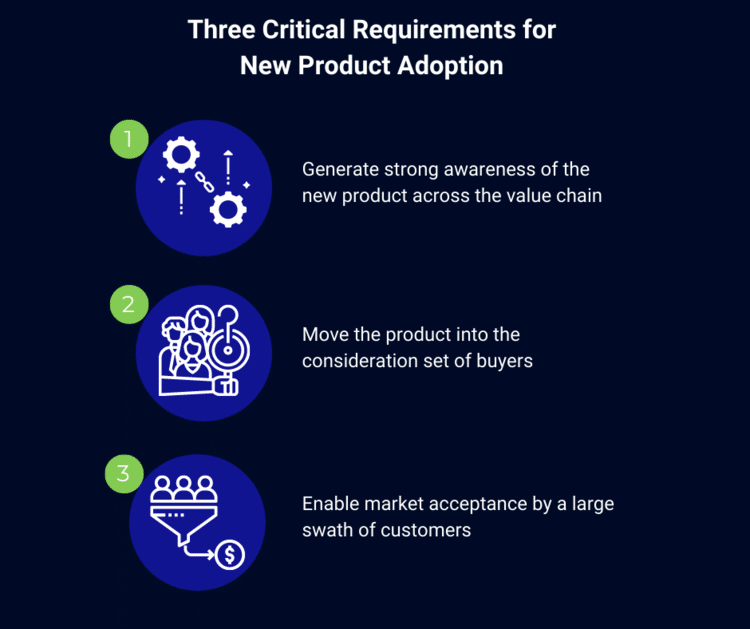Launch and Stay Launched
How do B2B companies accelerate adoption of new products and services?
Companies are not short of good ideas. Most businesses – even in the B2B space – are quite inventive with new and better things to sell – be it a roofing tile that lasts twice as long, software that lowers the cost of medical recordkeeping by 30%, or robotics that drive 15% cost reduction in warehousing. When priced competitively, these products all look like no-brainers. Yet, many of them end up on the chopping block within 30 months after launch due to lack of success.
In most cases, the ideas are not bad. For any new product launch, B2B companies face strong inertia –customers tend to continue using an existing, entrenched product that is good enough, instead of trying something new and better. It leads to slow, meandering adoption that ends up many years behind expectations. When faced with the need to deliver quarterly results, most corporations do not have the patience for prolonged timelines and often phase out new products before they are allowed to succeed.
So, what can B2B companies do to accelerate the adoption of new products and services? Based on our experience driving growth and innovation with dozens upon dozens of Fortune 500 enterprises, we identified five principles that have allowed businesses to avoid the dreadful fate that has befallen many new products.
Principle 1: Understand how to drive awareness, consideration, and market acceptance for each type of customer.
Prior to launch, most B2B companies are now conducting ample market research which often showcases how customers will line up to buy the new, improved product. However, this type of research only provides evidence on superior features without getting into how the products will be adopted by customers, which is the root of most launch failures.

In our work, we have seen three critical requirements to adoption – generating strong awareness of the new product across the value chain, moving the product into the consideration set of buyers, and enabling market acceptance by a large swath of customers. Companies need to understand how to move the needle on all three requirements for successful product adoption.
The building product industry provides great examples of how this works. In driving the adoption of a new residential roofing tile that is more impact-resistant and long-lasting than other similarly priced products, generating awareness must cover every stakeholder in the value chain, including developers, architects, general contractors, subcontractors, and homeowners. The level of awareness also needs to be deep enough to allow the likes of contractors to sell to homeowners on the benefits.
Then, when it comes to consideration, the roofing tile needs to be consistently available at the local distributor where the contractor purchases and the right competitive-displacement incentives must be in place because suppliers all have programs, such as volume-based discounts, rebates, and freebies (e.g., all-expense-paid trips), to keep loyalty. Finally, many contractors will neither purchase nor recommend the product to customers unless they have seen it used in the neighborhood without a hitch and have been trained on the installation. In addition, each type of construction – e.g., residential remodel, premium custom homes, starter production houses, etc. – needs different ways of driving awareness, consideration, and market acceptance. Only a company with a full grasp of all three requirements across customer segments would be able to drive results quickly.
Principle 2: Find the customers that will adopt a standard product early.
In the corporate world, quick results are essential to keep a product launched. Therefore, much of the success will rely on targeting the right initial customers. To overcome customer inertia, companies need to find buyers for whom there is a no-doubt, immediate-return business case, no upfront capital or investment barrier, and no externality that can slow the adoption.
To accelerate impact, businesses need to look for customers that do not have these barriers and for whith the standard offer will suffice. That way, the product can demonstrate viability by growing from customer #1 to customer #10 rapidly.
For example, in adopting robotics instead of manual processes for micro-fulfillment centers that service online orders of retail stores, there are many barriers – the warehouse may not have the right ceiling height, the floor may not support the weight of equipment, the last-mile delivery may not fit with the automation process. For robotics suppliers, these challenges can be overcome through the customization of equipment and design.
However, customization significantly slows initial adoption and is not easily replicable. To accelerate impact, businesses need to look for customers that have few adoption barriers and for which the standard offer will suffice. That way, the product can demonstrate viability by growing from customer #1 to customer #10 rapidly.
Principle 3: New products are sold, not bought, so do not underestimate the need for a strong ground game.
The ability of many consumer services to go viral has led many B2B companies to believe in foregoing people investment and focus on digital campaigns to market and sell new products. Yet, the old-fashioned person-to-person sale remains crucial. Even for the best-known venture unicorns – from Uber to Stripe, much of the capital raised has gone into market development or, more specifically, people in the field or on the phone to drive adoption.

In fintech, there has been significant growth in robo-advising for investment management. While the early adopters are internet-savvy consumers, successful companies in the space have all invested heavily in ground games that include large teams for conferences and webinars to run education programs, call centers to convert individual customers, and vast field sales to drive awareness at large companies and institutional investors. In nine out of ten cases, businesses that are willing to bet with the large commercial ground games will win out in the market.
Principle 4: Have clear path to commercialization before making significant investment in product development.
Plenty of literature has emerged in the last decade on minimally viable products to reduce upfront investment and maximize learnings. However, the application of this concept has been focused on product development which misses the point of validating not only the product but also the business. While having a product is valuable to understand how a new offer will be adopted, much of the work can be done synthetically.
For example, a robust conjoint analysis can provide vital information about the likely requirements for driving awareness, consideration, and market acceptance. Based on our experience, pairing such analysis with in-market validation through samples and conceptual illustrations can offer clear pictures of the path to successful commercialization and the underlying risks. Companies can then make informed decisions on further investment before embarking on the often lengthy and costly product development journey.
Principle 5: Iterate fast by focusing on what will move the needle.
As mentioned, speed is the essence of a new product launch, especially as most corporations run out of patience quickly. Therefore, making real-time adjustments on messaging, channel partners, and product features will be crucial. Successful companies have built strong feedback loops between the field and main office – where most of the marketing and product management reside – to drive rapid corrections.

It is also important to note that much of the initial market learnings before and after product launch will be just noise. Creating a commercialization plan is often an emotional rollercoaster where the new product’s perceived viability goes up and down daily based on each customer interaction. An important lesson to interpreting market learnings comes from the venture capital world, which assesses the viability of business primarily based on three factors: i) a large market with headroom that is addressable by the product; ii) unit economics that can be highly profitable at scale; iii) a team that can deal with problems that invariably occur during product launch. If market learnings continue to reaffirm those three points, the product should be viable.
New products are exciting for management teams. Driving adoption is often not, but that is mostly where successes and failures are determined. The final piece of advice – after all the hard work, all the trials and errors, all the investment into a new product, do not fumble on commercialization. Invest in the time, resources, and help needed to get it right.
About the Author
Xiao Liu is a principal in the Boston office. You can reach him at XLiu@Treacy.co

